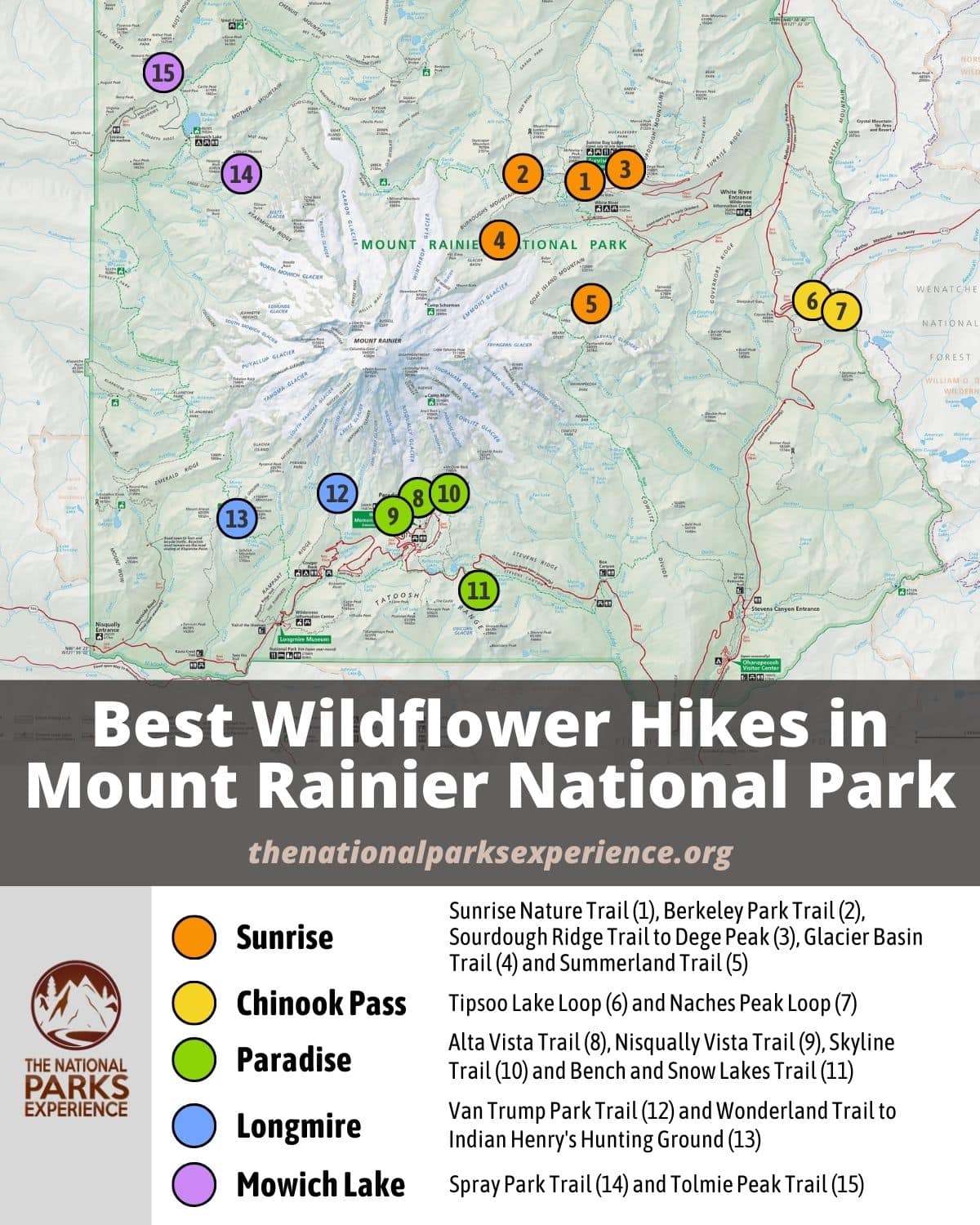Although (parts of) the park are open throughout the year, summer is the absolute peak season in Mount Rainier National Park. And there’s one main reason for that: spectacular displays of subalpine wildflowers.
While you can enjoy this natural spectacle from your vehicle or from crowded tourist areas, nothing compares to walking through these vibrant meadows on the park’s amazing hiking trails.
So, to help you have the best possible wildflower viewing experience, I’ve selected the very best wildflower hikes in Mount Rainier National Park for you below.
This blog post about the best wildflower hikes in Mount Rainier National Park contains affiliate links. You can read more about our Terms of Use / Disclosure here.
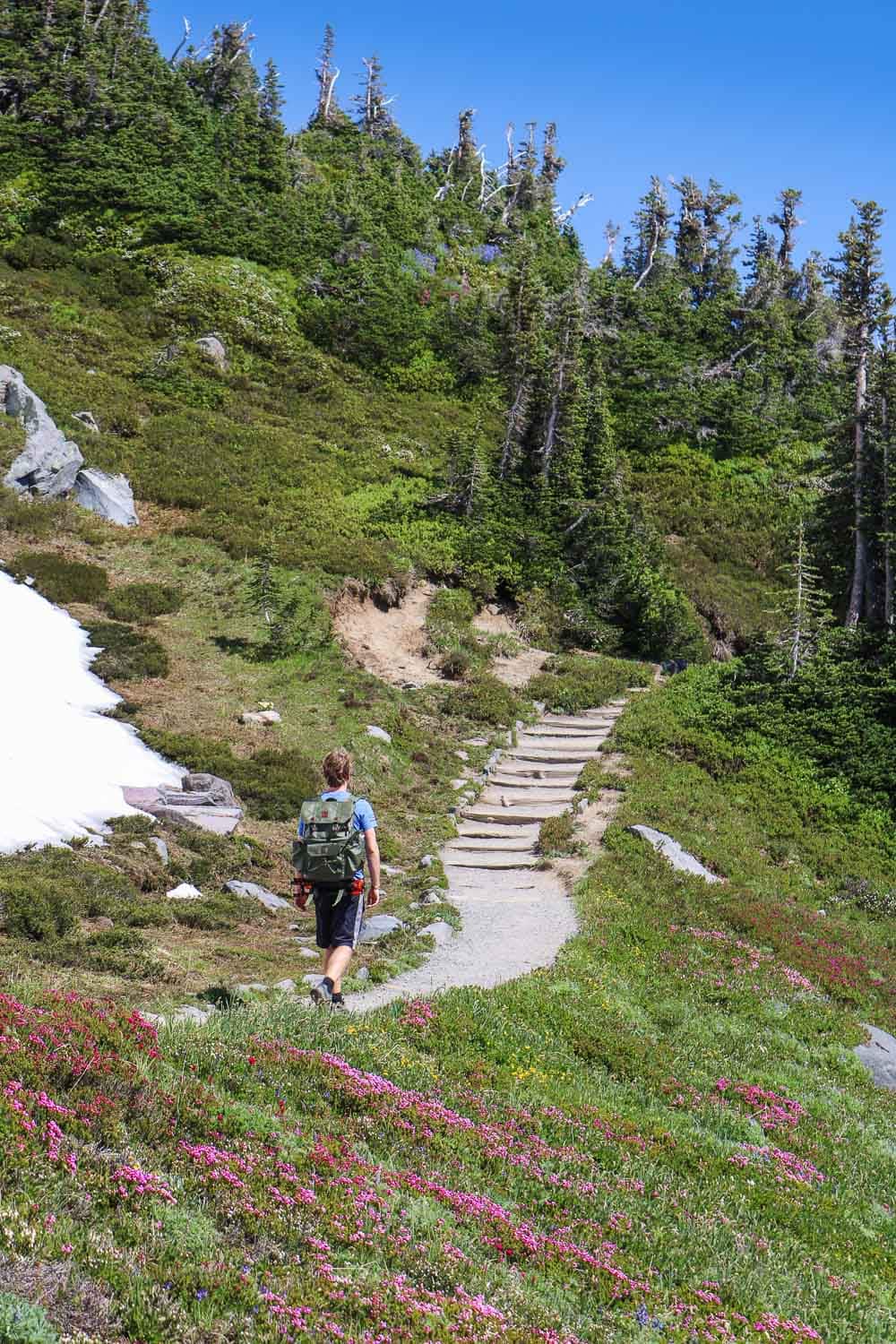
Contents
- Mount Rainier Wildflowers: The Basics
- More About Mount Rainier National Park
- Top 15 Best Wildflower Hikes in Mount Rainier National Park
- Best Wildflower Hikes at Sunrise, Mount Rainier
- Best Wildflower Hikes at Chinook Pass, Mount Rainier
- Best Wildflower Hikes at Paradise, Mount Rainier
- Best Wildflower Hikes at Longmire, Mount Rainier
- Best Wildflower Hikes at Mowich Lake, Mount Rainier
- Map of the Best Wildflower Hikes at Mount Rainier
Mount Rainier Wildflowers: The Basics
Before we start talking about the top wildflower hikes in Mount Rainier National Park, let’s first answer some common questions.
It is, for instance, very useful to know when the peak blooming season is, which areas have the most flowers, or which wildflower you can expect to see at Mount Rainier.
When Is the Peak Mount Rainier Wildflower Season?
Every summer, after the snow has melted at higher elevations, Mount Rainier National Park’s meadows burst into a rainbow-like display of wildflowers.
A few different factors affect when the actual peak bloom occurs every year, such as weather and the thickness of the year’s snowpack. This makes it difficult to provide accurate predictions way in advance.
That said, however, in a typical year “many flowers will be blooming by mid-July, and by the first of August the meadows should be very impressive,” according to park management.
So, generally speaking, the best time to see wildflowers in Mount Rainier National Park is from late-July through mid-August.
Frost can occur as early as late-August in the subalpine meadows, marking the end of the brief summer season. Yet, the meadows stay beautiful even after light frost, according to park management, as colors shift to the yellows and oranges of fall.
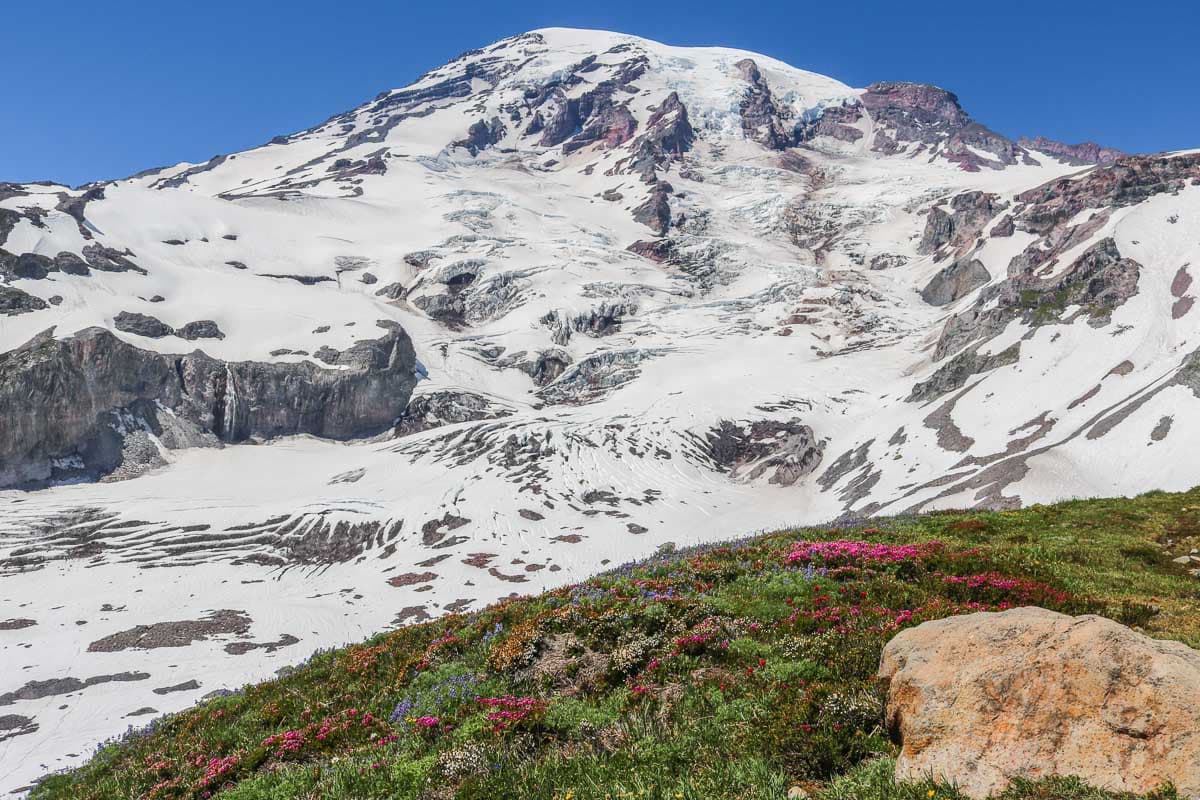
Where Can You See Wildflowers in Mount Rainier National Park?
Although all habitats in Mount Rainier National Park have their own particular flowers, the subalpine meadows are especially amazing in terms of wildflowers.
Located at elevations between 4,500 and 6,000 feet, this is the zone between the dense lower-elevation forests and the treeless alpine areas.
The subalpine meadows are sometimes also referred to as “parklands” because of their combination of meadows, shrubland and patches of trees. They’re mostly sprawling, open areas on the upper slopes of Mount Rainier, dotted with trees, as well as areas of huckleberries and other shrubs.
“Subalpine regions often have the most impressive wildflower displays because those regions have a very short growing season,” the park explains on its wildflower webpage.
“Snow can linger in the subalpine meadows well into June or July, and the flowers bloom profusely in order to reproduce as quickly as possible before the winter snows return.”
There are three particularly popular areas to see the wildflowers in Mount Rainier National Park, all of which are accessible by vehicle:
- Paradise: home to several fantastic wildflower trails, superb views, waterfalls, the park’s main visitor center, and the historic Paradise Inn.
- Sunrise: highest point in the park accessible by vehicle, beautiful subalpine meadows, a variety of trails, and visitor services.
- Chinook Pass: phenomenal view of Tipsoo Lake and Mount Rainier, relatively small area but home to abundant summer wildflowers, trails range from easy to moderate.
In addition to those three Mount Rainier wildflower viewing areas, there are a couple of others that also feature impressive displays of flowers. They’re much more remote, though, and require either a long drive or hike:
- Mowich Lake: remote area in the northwest corner of the park, accessible via a gravel road, with trails leading to wildflower areas such as Spray Park and Eunice Lake.
- Parklands on Mount Rainier’s south(west) slopes: trails starting on the road between the Nisqually Entrance and Paradise lead to subalpine “parks” like Van Trump Park and Indian Henry’s Hunting Ground.
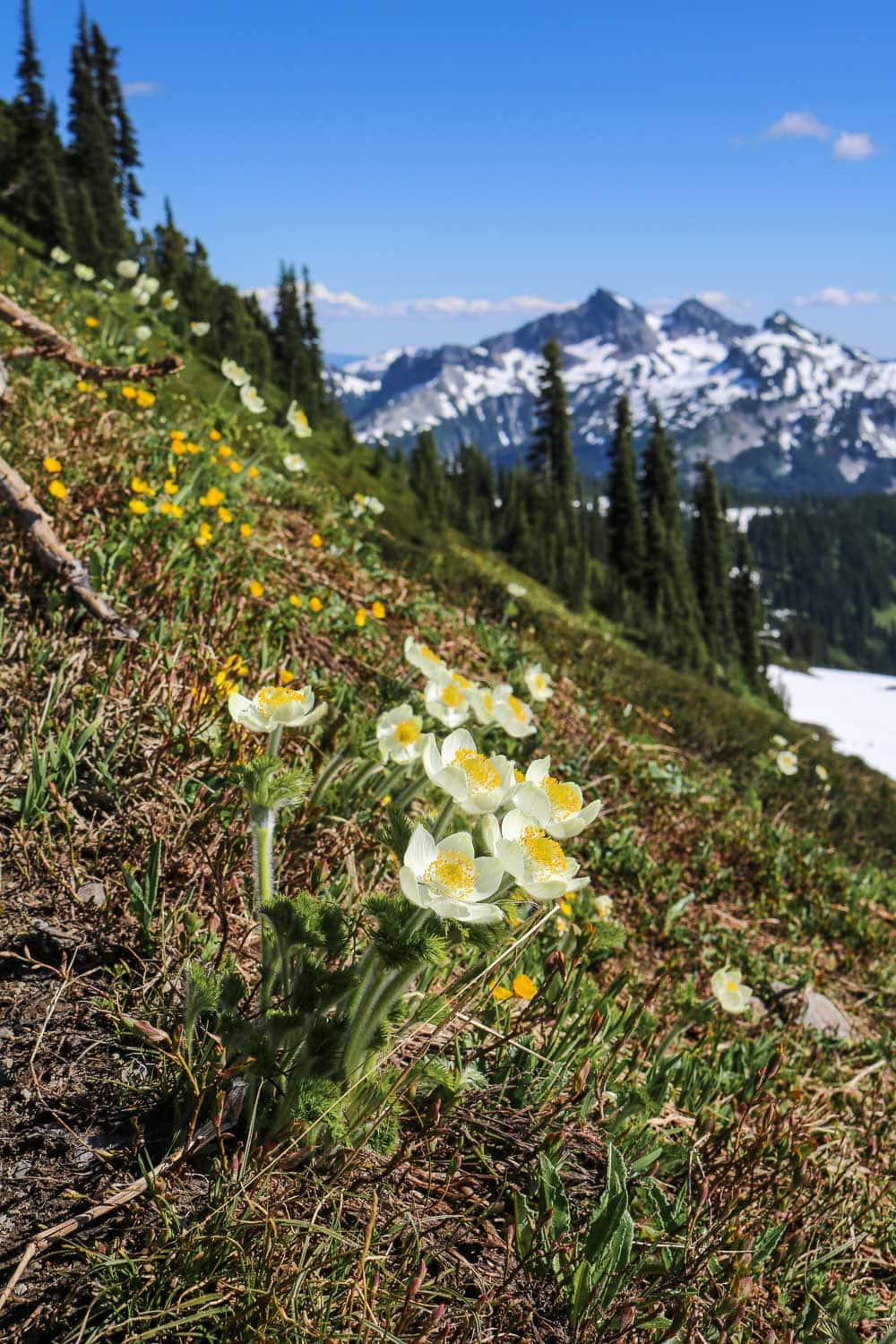
Which Wildflowers Can You See in the Mount Rainier Meadows?
Mount Rainier National Park is home to literally hundreds of species of wildflowers. Many, if not most, of those are found in the park’s subalpine meadows.
While it’s impossible to show or talk about all of them here, I can tell you about several flowers you’re most likely to see during your visit to the park.
Mount Rainier wildflowers cover all colors of the rainbow, from red and yellow to blue and violet, along with numerous white flowers, too. When exploring Mount Rainier National Park, look for these beautiful wildflowers:
WHITE
- Avalanche Lily (Erythronium montanum)
- Bear Grass (Xerophyllum tenax)
- Coiled-beak Lousewort (Pedicularis contora)
- Gray’s Lovage (Ligusticum grayi)
- Marsh Marigold (Caltha leptosepala)
- Mountain Sandwort (Arenaria capillaris)
- Pasqueflower or Western Anemone (Anemone occidentalis)
- Sitka Valerian (Valeriana sitchensis)
- White Mountain Heather (Cassiope mertensiana)
RED & PINK
- Elephant’s Head (Pedicularis groenlandica)
- Magenta Paintbrush (Castilleja parviflora)
- Scarlet Paintbrush (Castilleja miniata)
- Pink Monkeyflower (Mimulus lewisii)
- Pink Mountain Heather (Phyllodoce empetriformis)
- Rosy Spirea (Spirea splendens)
- Spreading Phlox (Phlox diffusa)
- Subalpine Daisy (Erigeron peregrinus)
- Western Spring-Beauty (Claytonia lanceolara var. lanceolata)
YELLOW & ORANGE
- Arrowleaf Groundsel (Senecio triangularis)
- Broadleaf Arnica (Arnica latifolia)
- Fan-leaf Cinquefoil (Potentilla flabellifolia)
- Glacier Lily (Erythronium grandiflorum)
- Mount Rainier Lousewort (Pedicularis rainierensis)
- Oregon Sunshine (Eriophyllum lanatum)
- Rainiera (Rainiera stricta)
- Yellow Willowherb (Epilobium luteum)
BLUE & PURPLE
- Alpine Aster (Oresostemma alpigenum)
- Cascade Aster (Eucephallus ledophyllus)
- Cascade Penstemon (Penstemon serrulatus)
- Broadleaf Lupine (Lupinus latifolius)
- Dwarf Lupine (Lupinus lepidus)
- Common Harebell (Campanula rotundifolia)
- Cusick’s Speedwell (Veronica cusickii)
- Edible Thistle (Cirsium edule)
- Jeffrey’s Shooting Star (Dodecatheon jeffreyi)
- Mountain Bog Gentian (Gentiana calycosa)
- Tall Bluebells (Mertensia paniculata)
What Is the Current Mount Rainier Wildflower Blooming Status?
For the current wildflower blooming status—what is blooming where at Mount Rainier—you can check the “currently blooming” section here on the park’s website.
See More Mount Rainier Wildflower Information Here
More About Mount Rainier National Park
- Park Website
- Travel Guide
- Topographic Map
- Top Things To Do in Mount Rainier National Park
- What to Do at Paradise (Mount Rainier)
- Best Mount Rainier Sunset Spots
- Best Views of Mount Rainier
- Accommodation
Top 15 Best Wildflower Hikes in Mount Rainier National Park
These are my personal favorite Mount Rainier wildflower hikes, the best trails to see wildflowers in Mount Rainier National Park.
They’re divided into five different areas in the park: Sunrise, Chinook Pass, Paradise, Longmire, and Mowich Lake.
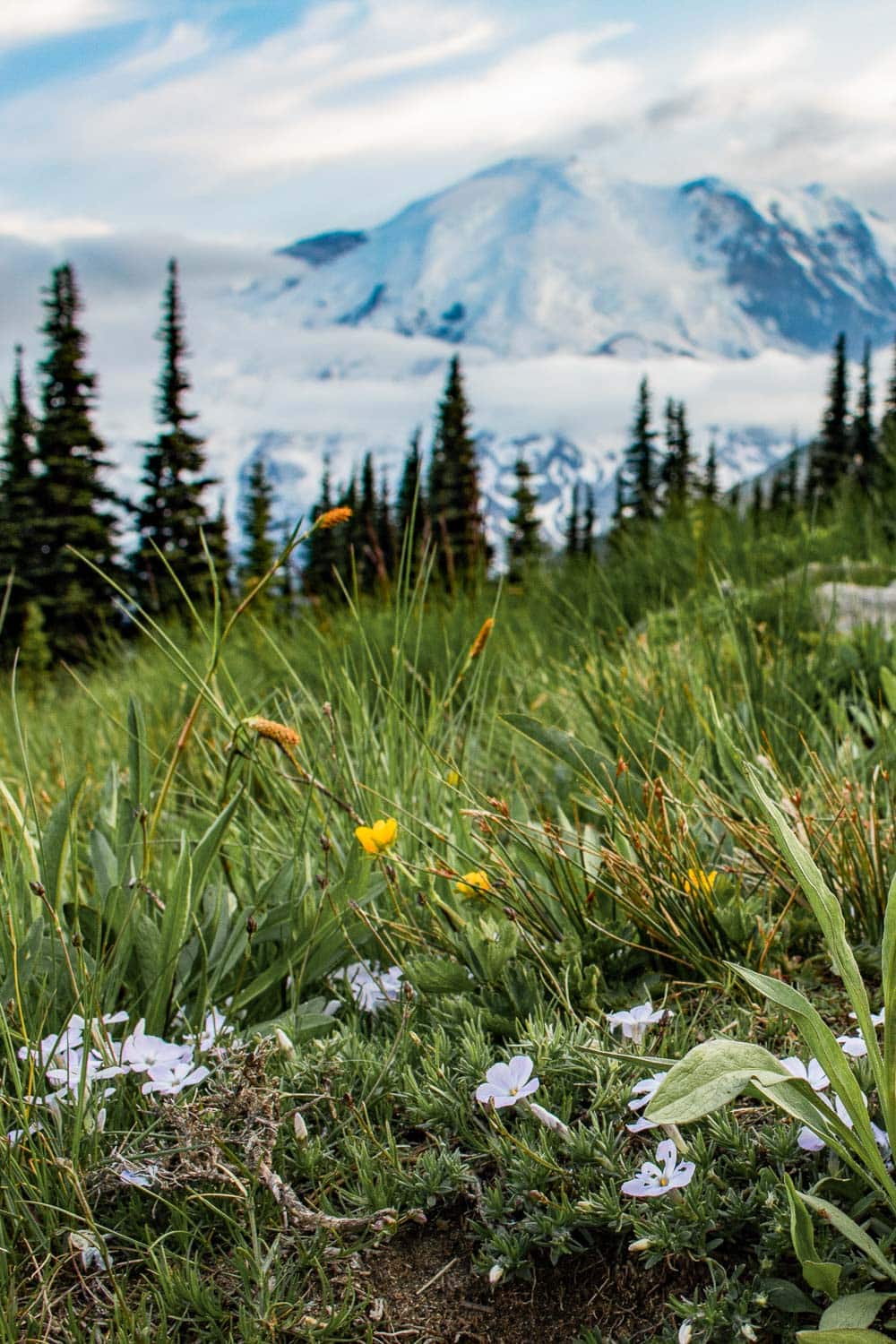
Best Wildflower Hikes at Sunrise, Mount Rainier
1. Sunrise Nature Trail
The often-crowded Sunrise Nature Trail is a short self-guided 1.5-mile hike through the meadows of Yakima Park.
It is one of the easiest wildflower hikes at Sunrise, offering great views of Mount Rainier and the opportunity to immerse yourself in a subalpine wildflower meadow.
This is great wildflower hike at Sunrise for people who don’t feel like doing a more challenging hike, yet still want to enjoy the spectacular subalpine flowers at Mount Rainier.
- Distance: 1.5 miles, loop
- Duration: 30-45 minutes
- Difficulty: Easy
- Trailhead: Behind the Sunrise Visitor Center
2. Berkeley Park Trail
Only a few miles west of the Sunrise Visitor Center lies a true subalpine gem known as Berkeley Park.
This is somewhat of an underrated wildflower hiking destination in Mount Rainier National Park, especially since most hikers at Sunrise will focus on places like Dege Peak, Burroughs Mountain, and Mount Fremont Lookout.
The first sections of this beautiful hike are on the Sourdough Ridge Trail, followed by the Wonderland Trail. Berkeley Park is just down the trail on the right, at the intersection where the Wonderland Trail runs to the left.
In summer, this is a wildflower wonderland, a paradisiacal place home to pikas and marmots, as well as deer and the occasional black bear.
- Distance: 7.7 miles, out and back
- Duration: 4 hours
- Difficulty: Moderate/challenging
- Trailhead: Sunrise Visitor Center
3. Sourdough Ridge Trail to Dege Peak
Running just above the popular Sunrise Area, Sourdough Ridge offers jaw-dropping views of Mount Rainier. It’s one of my favorite hikes for subalpine wildflowers in Mount Rainier National Park.
The Sourdough Ridge Trail runs through the Sunrise meadows and climbs gently eastward to Dege Peak. It’s a moderate hike—experienced hikers will say it’s easy—that offers constant views of Rainier.
Toward the end, you’ll see other iconic Cascade mountains in the distance, including Mount Baker, Mount Adams, and Glacier Peak.
Although the area is called Sunrise, this is arguably my favorite place in the entire national park for sunset hikes.
As crazy busy as it is during the day, the area is surprisingly quiet and peaceful at dusk. That’s also when the wild animals come out and sightings of Columbia black-tailed deer, Cascade red foxes and even black bears aren’t unusual.
- Distance: 4.2 miles, out and back
- Duration: 2 hours
- Difficulty: Moderate
- Trailhead: Behind the Sunrise Visitor Center
4. Glacier Basin Trail
“In summer, the meadows of the basin are a rainbow of wildflowers. Watch for mountain goats on the surrounding slopes and mountain climbers ascending the Inter Glacier to Camp Schurman,” the National Park Service says.
“After the first mile, a 0.5 mile spur trail leads along the Emmons Moraine to a view of the Emmons Glacier, the largest glacier in the lower 48 states. Stay on designated trails to protect fragile plants.”
- Distance: 7 miles, out and back
- Duration: 4 hours
- Difficulty: Challenging
- Trailhead: White River Campground
5. Summerland Trail
From the trailhead, “the trail ascends gradually through mature forest for several miles before entering the upper valley of Fryingpan Creek where hikers find good views of Mount Rainier,” according to the National Park Service.
“Shortly after crossing the creek at a small cascade, the trail climbs steeply for another .5 mile before reaching the open subalpine meadows of Summerland.”
Thanks to the spectacular summer wildflowers, “this is one of Mount Rainier’s most crowded trails, hosting several hundred hikers per day on a nice summer weekend.”
- Distance: 8.4 miles, out and back
- Duration: 5 hours
- Difficulty: Moderate
- Trailhead: Small parking lot just past the bridge across Fryingpan Creek on Sunrise Road
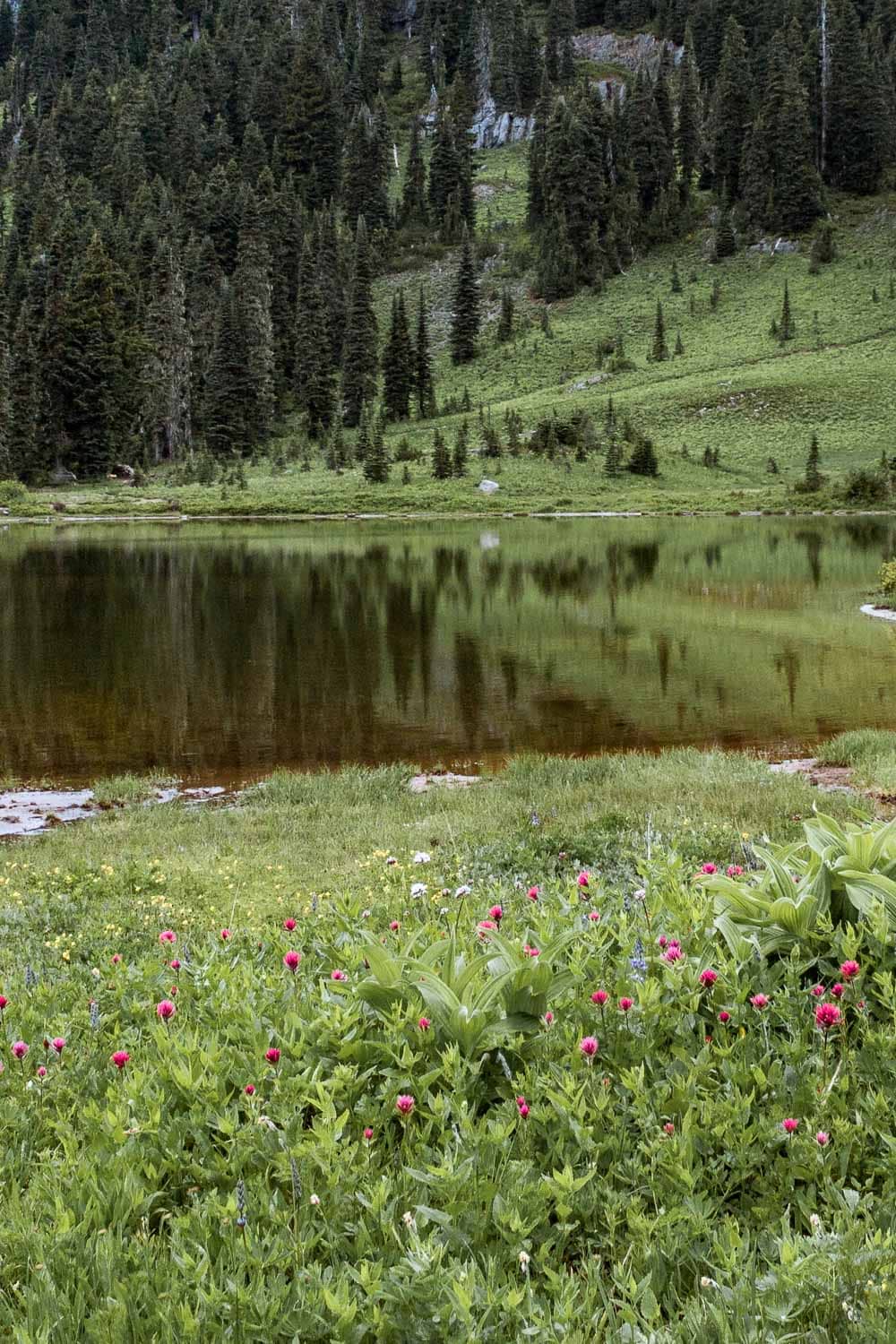
Best Wildflower Hikes at Chinook Pass, Mount Rainier
6. Tipsoo Lake Loop
Only reachable in summer, usually from June to October, Tipsoo Lake is one of my favorite places in Mount Rainier National Park.
It’s an incredibly picturesque area, the small lake backed by mighty Mount Rainier and surrounded by gorgeous meadows.
In fact, if you’re looking for the best views of Mount Rainier, it really doesn’t get any better than the Tipsoo Lake and Chinook Pass area, which is especially stunning at sunrise and sunset.
Sitting in a glacier-carved basin, Tipsoo Lake is home to spectacular wildflowers in summer, particularly from mid to late July.
You can walk around Tipsoo Lake on a short lakeshore loop trail lined with flowers. Park at either the Tipsoo Lake Picnic Area or a bit further up the road toward Chinook Pass.
- Distance: 0.5 miles, loop
- Duration: 15-20 minutes
- Difficulty: Very easy
- Trailhead: Tipsoo Lake Picnic Area
7. Naches Peak Loop
One of the most popular Mount Rainier hikes for families, the 3.5-mile Naches Peak Loop is an easy circuit that takes in beautiful Tipsoo Lake, Chinook Pass, and Naches Peak.
It’s everything you might expect from a hike in Mount Rainier National Park, from colorful subalpine wildflowers to spectacular views. Additionally, because of an abundance of huckleberries, it’s also one of the best Mount Rainier fall hikes.
For the best views of Mount Rainier, I recommend hiking this trail in a clockwise direction. Start at the Tipsoo Lake parking area and follow the trail up to Chinook Pass and the Pacific Crest Trail.
You’ll walk along the east side of Naches Peak and take the Naches Peak Loop Trail back to Tipsoo Lake.
- Distance: 3.5 miles, loop
- Duration: 2 hours
- Difficulty: Easy/moderate
- Trailhead: Tipsoo Lake Picnic Area or Chinook Pass
Note: Part of the Naches Peak Loop is in Mount Rainier National Park, while the other part is in adjacent National Forest land. Dogs are only allowed on the Pacific Crest Trail section outside of the national park, and only on a leash. They’re not allowed on the Naches Peak Loop Trail inside the park.
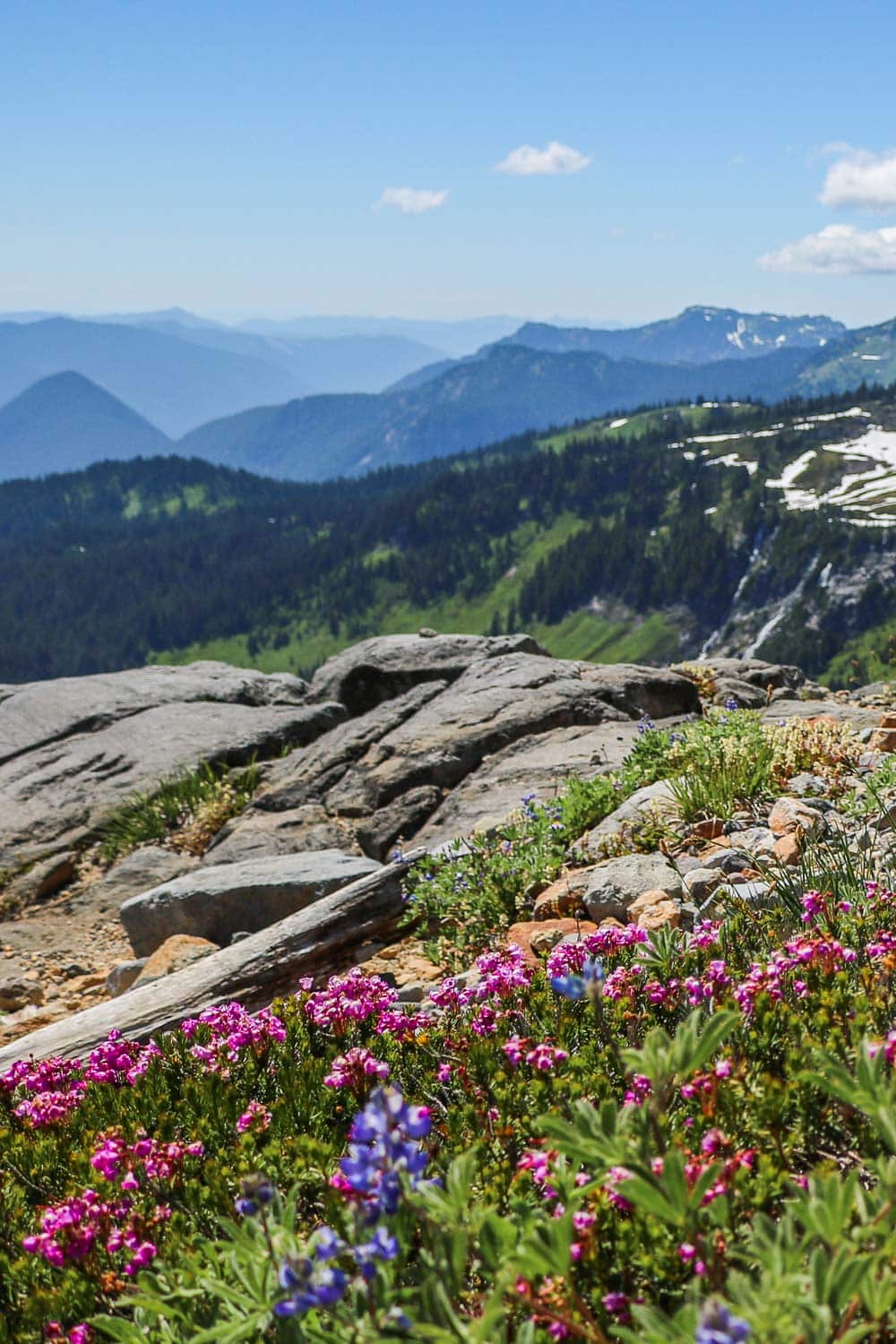
Best Wildflower Hikes at Paradise, Mount Rainier
8. Alta Vista via the Alta Vista and Skyline Trails
One of many trails that make up the trail network at Paradise, the Alta Vista Trail makes for a short yet incredibly scenic wildflower hike.
Combined with the first short section of the Skyline Trail, it’s a delightful lollipop-shaped loop through the glorious meadows of Paradise.
Although some stretches may be quiet steep, this is generally a pretty easy hike, ideal for families with small kids or visitors with limited time.
- Distance: 1.75 miles, lollipop
- Duration: 1 hour
- Difficulty: Easy/moderate
- Trailhead: Behind the Henry M Jackson Memorial Visitor Center
9. Nisqually Vista Trail
If you’re looking for the best easy hikes in Mount Rainier that offer both wildflowers and views of the mountain, I strongly recommend the Nisqually Vista Trail.
This easy 1.2-mile loop hike starts at the west end of the lower Paradise parking area and is suitable for families with strollers. Along the way, you’ll get to immerse yourself in gorgeous summer wildflowers. (It’s also stunning in the fall!)
As you walk through the meadows of Paradise, you’ll always be accompanied by great views of Mount Rainier itself. The trail is named after the massive Nisqually Glacier, which is clearly visible on this wonderful Mount Rainier wildflower hike.
Additionally, if you’re lucky, you might also spot some wildlife here. Deer frequent the Paradise meadows and are common sights, as are smaller mammals like chipmunks, ground squirrels, and marmots.
I’ve even seen a couple of black bears here!
- Distance: 1.2 miles, lollipop
- Duration: 30-45 minutes
- Difficulty: Easy
- Trailhead: West end of the lower Paradise parking area
10. Skyline Trail
Arguably the most popular—for a reason!—trail in Mount Rainier National Park, the Skyline Trail provides a magnificent immersion in the wildflower meadows of Paradise.
This phenomenal 5.5-mile loop hike starts at the Jackson Visitor Center at Paradise, behind the iconic Paradise Inn. The trail climbs 1,700 feet to well above the tree line.
In summer, the Skyline Trail is where you need to be for some of the absolute best wildflower viewing at Mount Rainier.
You’ll walk through gorgeous alpine meadows filled with all kinds of flowers, including Indian paintbrush, lupines, and avalanche lilies, along with dozens of other species.
Other major highlights on this hike are the massive Nisqually Glacier and Panorama Point, which offers breathtaking panoramic views of the Cascade Range.
This vista includes several other volcanoes, such as Mount Adams and even Mt. Hood all the way to the south.
Additionally, you can also see some of Mount Rainier’s greatest waterfalls along the Skyline Trail. Especially gorgeous Myrtle Falls is a popular attraction and one of the many highlights of this amazing wildflower hike.
This postcard-perfect waterfall is a scene that seems too good to be real. Surrounded by verdant wildflowers meadows, backed by an unobstructed view of Mount Rainier itself, it’s incredibly photogenic.
- Distance: 5.5 miles, loop
- Duration: 3-4 hours
- Difficulty: Challenging
- Trailhead: Behind the Henry M Jackson Memorial Visitor Center
11. Bench and Snow Lakes Trail
The National Park Service says that hikers can “enjoy two lakes along this one trail. In summer, this area is an excellent place to see bear grass and meadow flowers. The trail is a succession of gradual ups and downs crossing low ridges, reaching Bench Lake after 0.75 mile, then continuing another 0.5 mile to Snow Lake.”
- Distance: 2.5 miles, out and back
- Duration: 1-2 hours
- Difficulty: Moderate
- Trailhead: 1.5 miles east of Reflection Lakes on Stevens Canyon Road
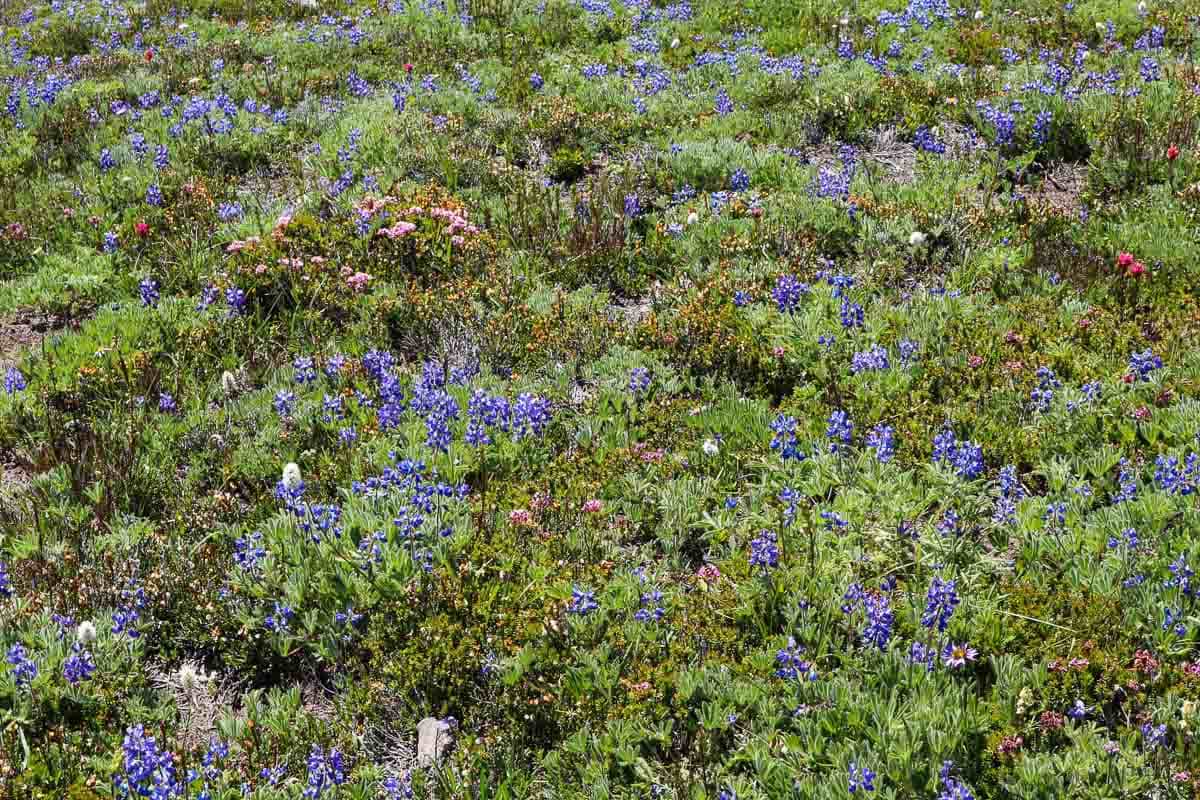
Best Wildflower Hikes at Longmire, Mount Rainier
12. Van Trump Park Trail
Comet Falls, a 320-foot waterfall, is a super-popular hiking destination in this corner of Mount Rainier National Park, but I recommend going a bit further and also visiting the pristine wildflowers meadows of Van Trump Park.
According to the National Park Service, “one of the highest waterfalls in the park, Comet Falls was named because it resembles the tail of a comet. Van Trump Park honors P. B. Van Trump, who, with Hazard Stevens, was one of the first people to stand on the summit of Mount Rainier.”
In addition to the beautiful wildflowers, Van Trump Park also offers superb views of Mount Adams and Mount St. Helens to the south.
Looking north and up, you can admire the Van Trump and Kautz Glaciers on the south flank of Mount Rainier.
Also make sure to listen and look around you. These meadows and the surrounding rocky slopes are home to pikas, marmots, and mountain goats.
- Distance: 5.8 miles, out and back
- Duration: 3-4 hours
- Difficulty: Challenging
- Trailhead: Comet Falls Trailhead, about 4 miles east of Longmire
13. Wonderland Trail to Indian Henry’s Hunting Ground
The hike to Indian Henry’s Hunting Ground is by far the longest of all the Mount Rainier wildflower hikes featured here. But it’s absolutely worth it!
You can start this phenomenal full-day hike at either Kautz Creek or Longmire. Whichever trailhead you choose, it’ll be a challenging hike of more than 11 miles, which will take you a minimum of six hours (but quite possibly more).
On the way, you’ll walk through beautiful forests and cross streams as you climb higher and higher toward the tranquil meadows of Indian Henry’s Hunting Ground.
The length and duration of this hike deter many hikers, but those who do invest time and effort will be rewarded by an unforgettable experience.
Along with the stunning scenery, the solitude offered by this hike is one of its main drawcards.
In fact, Indian Henry’s Hunting Ground is easily one of the greatest places to immerse yourself—in peace and quiet—in the stunning wildflowers of Mount Rainier. Stay on the trail, though!
- Distance: 11.5 miles (via Kautz Creek) or 13 miles (via Longmire), out and back
- Duration: 6-7 hours (via Kautz Creek) or 8 hours (via Longmire)
- Difficulty: Challenging
- Trailhead: Kautz Creek Trailhead or Longmire
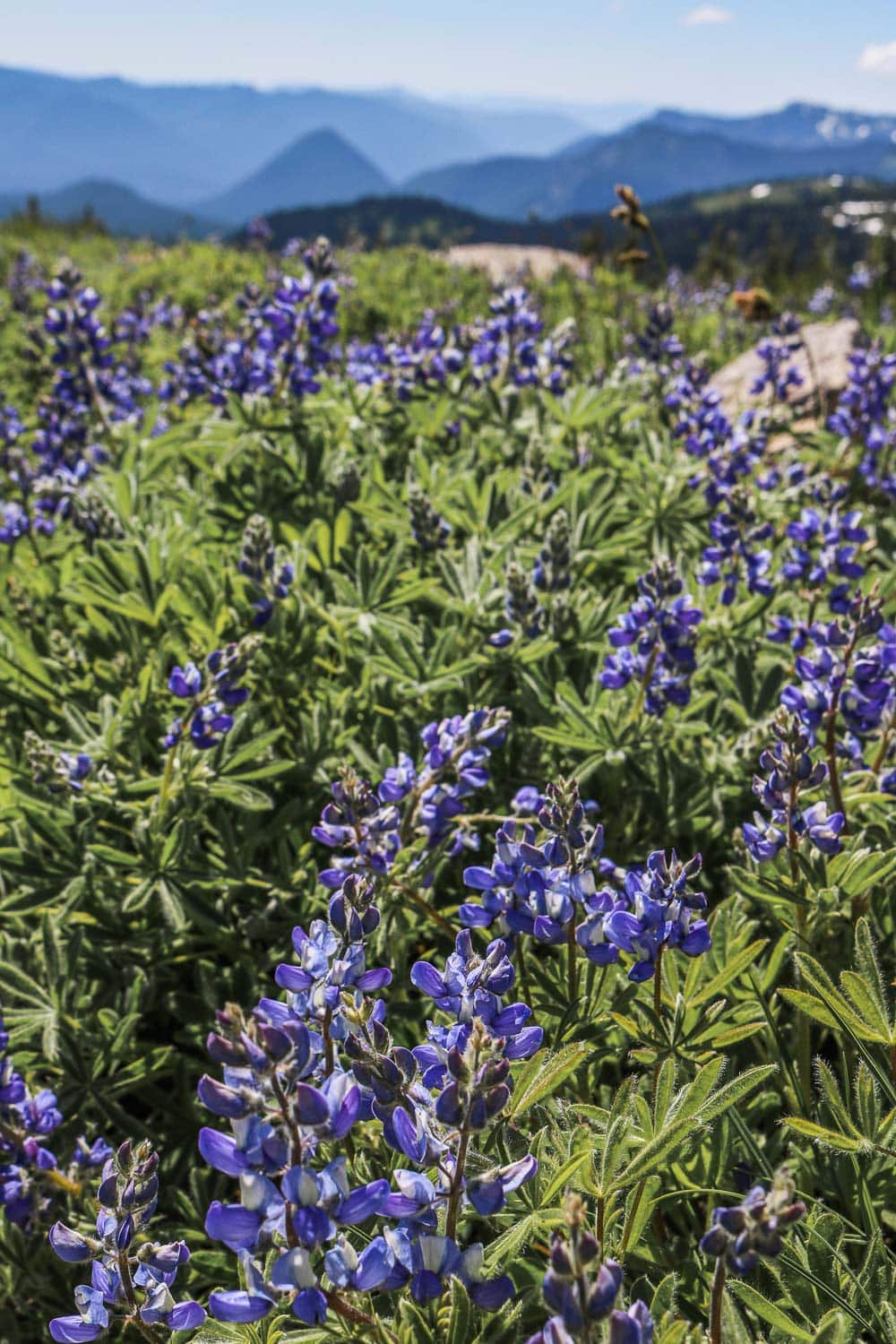
Best Wildflower Hikes at Mowich Lake, Mount Rainier
14. Spray Park Trail
The hike to Spray Park starts on the south shore of Mowich Lake. You’ll first follow the Wonderland Trail for about 0.25 miles before turning left onto the Spray Park Trail.
“Follow the Spray Park Trail east for two miles, as it weaves up and down through forested terrain, across Lee Creek, and eventually to the junction with a spur trail to view Spray Falls,” the National Park Service says.
“The next half mile to the first meadows of Spray Park is a steep climb up a series of switchbacks. More extensive meadows are found in another half mile.”
Most of the Spray Park Trail is through predominantly open forest, while Eagle’s Cliff Overlook provides a great view of Mount Rainier and the Mowich Glacier.
Once you get to Spray Park, however, the scenery is mainly subalpine meadows filled with summer flowers, which “rival the beauty of any in the park.”
- Distance: 6 miles, out and back
- Duration: 3-4 hours
- Difficulty: Moderate/challenging
- Trailhead: Mowich Lake
15. Tolmie Peak Trail
This spectacular “trail climbs through the forest to Eunice Lake, then ascends to the Tolmie Peak fire lookout for views of Mount Rainier and the surrounding areas,” the National Park Service explains on its website.
The agency asks hikers to “please stay on the trail to avoid damaging the meadows surrounding the lake,” an area that often sees superb wildflower blooms in summer.
- Distance: 6.5 miles, out and back
- Duration: 4 hours
- Difficulty: Challenging
- Trailhead: Mowich Lake
Map of the Best Wildflower Hikes at Mount Rainier
